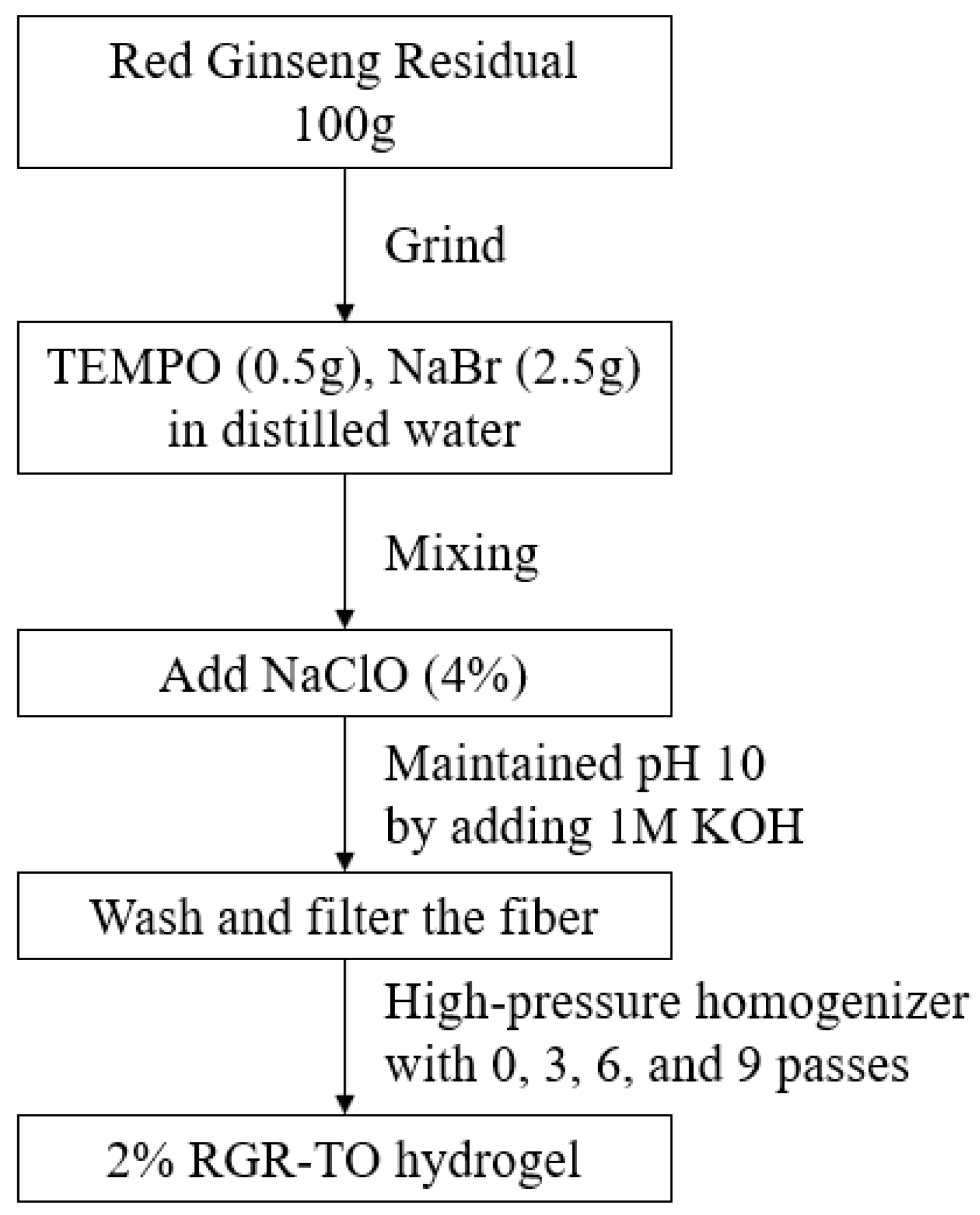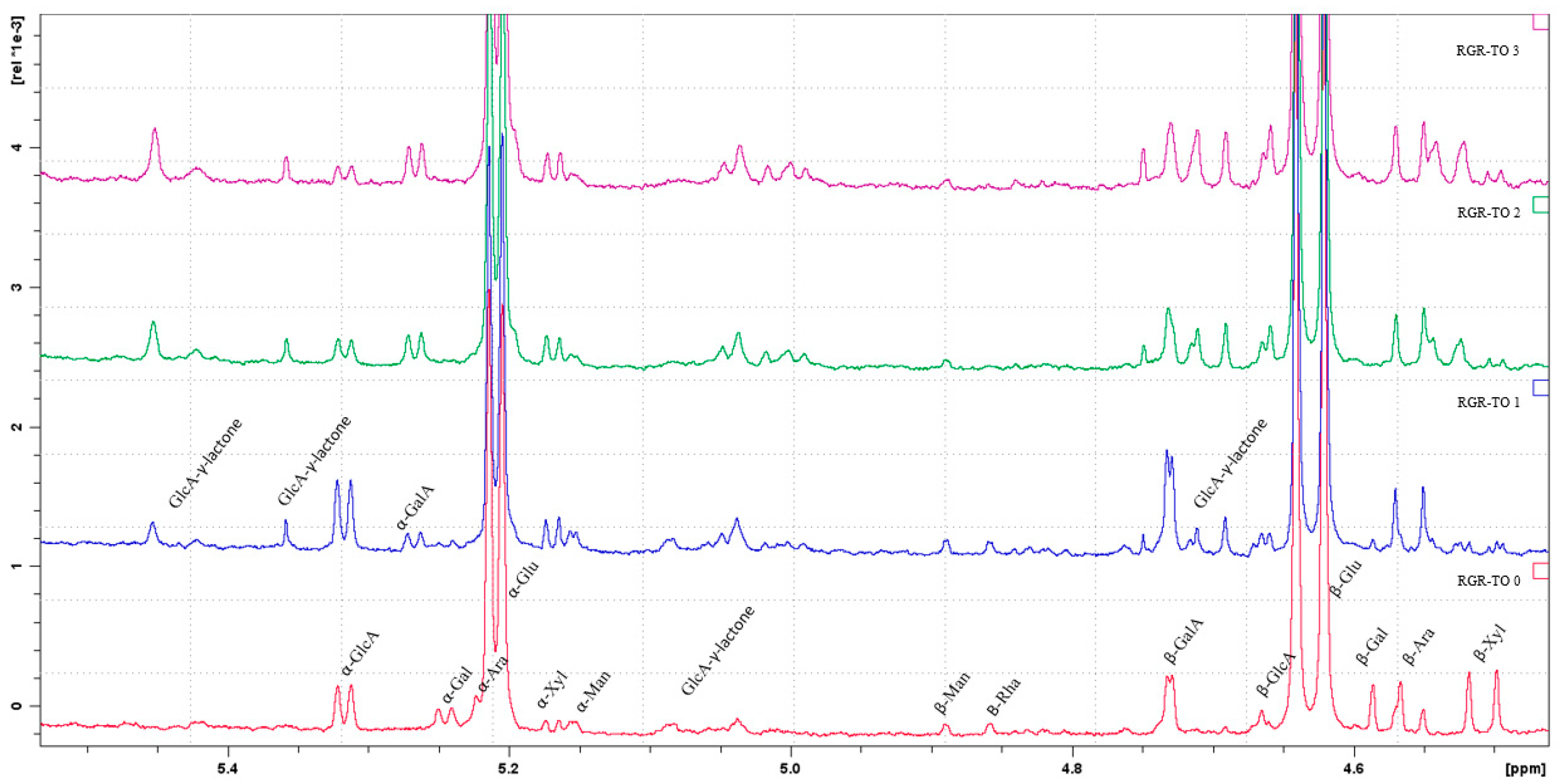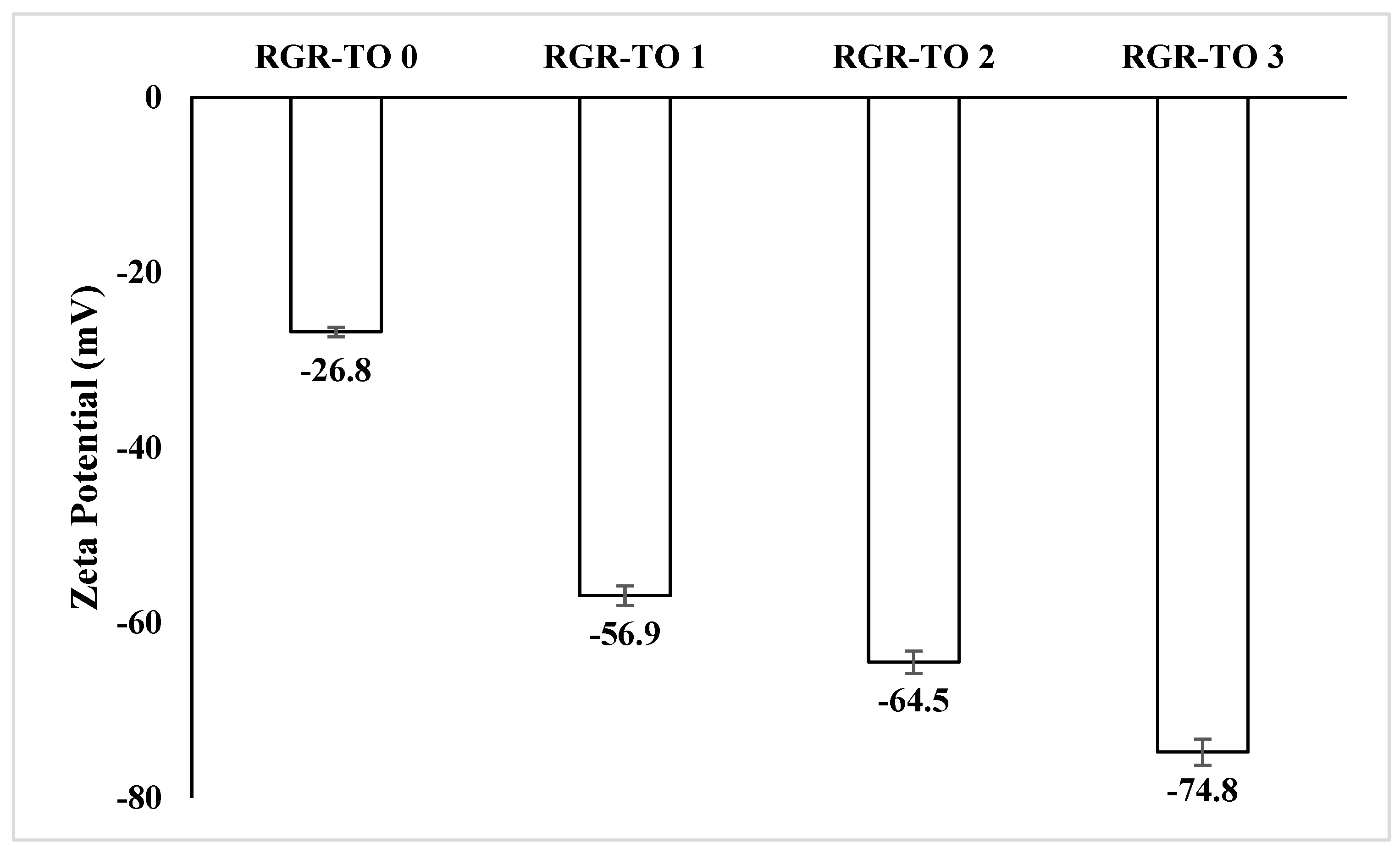Impact of TEMPO-Oxidation Pretreatment of Red Ginseng Residual on Nanofibrillation
Abstract
1. Introduction
2. Materials and Methods
2.1. Materials
2.2. Preparation of Red Ginseng Residual Nanoparticles in Different TEMPO-Oxidations
2.3. Analysis of Chemical Composition
2.4. Degree of Oxidation Analysis
2.5. Zeta Potential Measurement
2.6. Nanoparticle Analysis
2.7. Statistical Data Analyses
3. Result and Discussion
3.1. Chemical Composition of Red Ginseng Residual Treated and Untreated TEMPO-Oxidation
3.2. Zeta Potential of Red Ginseng Residual-Treated and Untreated TEMPO-Oxidation
3.3. Size of Red Ginseng Residual-Treated and Untreated TEMPO-Oxidation
4. Conclusions
Author Contributions
Funding
Institutional Review Board Statement
Data Availability Statement
Conflicts of Interest
References
- Ahmed, M.B.; Zhou, J.L.; Ngo, H.H.; Guo, W.; Chen, M. Progress in the Preparation and Application of Modified Biochar for Improved Contaminant Removal from Water and Wastewater. Bioresour. Technol. 2016, 214, 836–851. [Google Scholar] [CrossRef]
- Kim, D.; Park, M.; Haleem, I.; Lee, Y.; Koo, J.; Na, Y.C.; Song, G.; Lee, J. Natural product Ginsenoside 20 (S)-25-methoxyl-dammarane-3β, 12β, 20-triol in cancer treatment: A review of the pharmacological mechanisms and pharmacokinetics. Front. Pharmacol. 2020, 11, 521. [Google Scholar] [CrossRef]
- Kim, Y.J.; Perumalsamy, H.; Castro-Aceituno, V.; Kim, D.; Markus, J.; Lee, S.; Kim, S.; Liu, Y.; Yang, D.C. Photoluminescent and self-assembled hyaluronic acid-zinc oxide-ginsenoside Rh2 nanoparticles and their potential caspase-9 apoptotic mechanism towards cancer cell lines. Int. J. Nanomed. 2019, 2019, 8195–8208. [Google Scholar] [CrossRef]
- Wenli, S.; Shahrajabian, M.H.; Qi, C. Therapeutic roles of goji berry and ginseng in traditional Chinese. J. Nutr. Food Secur. 2019, 4, 293–305. [Google Scholar] [CrossRef]
- Sengupta, P.; Dutta, S. Panax ginseng as reproductive medicine in male infertility: With a brief focus on herb-drug interaction. Chem. Biol. Lett. 2022, 9, 279. [Google Scholar]
- Zhang, Z.; Zhou, Y.; Fan, H.; Billy, K.J.; Zhao, Y.; Zhan, X.; Yang, L.; Jia, Y. Effects of Lycium barbarum polysaccharides on health and aging of C. elegans depend on daf-12/daf-16. Oxidative Med. Cell. Longev. 2019, 2019, 6379493. [Google Scholar] [CrossRef]
- Zhang, H.E.; Chu, M.Y.; Jiang, T.; Song, X.H.; Hou, J.F.; Cheng, L.Y.; Feng, Y.; Chen, C.B.; Wang, E.P. By-product of the red ginseng manufacturing process as potential material for use as cosmetics: Chemical profiling and in vitro antioxidant and whitening activities. Molecules 2022, 27, 8202. [Google Scholar] [CrossRef]
- Payne, D. Skin integrity in older adults: Pressure-prone, inaccessible areas of the body. Br. J. Community Nurs. 2020, 25, 22–26. [Google Scholar] [CrossRef]
- Meng, H.; Liu, X.K.; Li, J.R.; Bao, T.Y.; Yi, F. Bibliometric analysis of the effects of ginseng on skin. J. Cosmet. Dermatol. 2022, 21, 99–107. [Google Scholar] [CrossRef]
- Jiménez, Z.; Kim, Y.J.; Mathiyalagan, R.; Seo, K.H.; Mohanan, P.; Ahn, J.C.; Kim, Y.J.; Yang, D.C. Assessment of radical scavenging, whitening and moisture retention activities of Panax ginseng berry mediated gold nanoparticles as safe and efficient novel cosmetic material. Artif. Cells Nanomed. Biotechnol. 2018, 46, 333–340. [Google Scholar] [CrossRef] [PubMed]
- Shin, S.J.; Park, Y.H.; Jeon, S.G.; Kim, S.; Nam, Y.; Oh, S.M.; Lee, Y.Y.; Moon, M. Red ginseng inhibits tau aggregation and promotes tau dissociation in vitro. Oxidative Med. Cell. Longev. 2020, 2020, 7829842. [Google Scholar] [CrossRef]
- Solano, F. Photoprotection and skin pigmentation: Melanin-related molecules and some other new agents obtained from natural sources. Molecules 2020, 25, 1537. [Google Scholar] [CrossRef]
- Lakhan, M.K.; Lynch, M. Skin pigmentation. Medicine 2021, 49, 447–452. [Google Scholar] [CrossRef]
- Hyun, S.H.; Kim, S.W.; Seo, H.W.; Youn, S.H.; Kyung, J.S.; Lee, Y.Y.; In, G.; Park, C.K.; Han, C.K. Physiological and pharmacological features of the non-saponin components in Korean Red Ginseng. J. Ginseng Res. 2020, 44, 527–537. [Google Scholar] [CrossRef]
- Lee, S.M.; Bae, B.S.; Park, H.W.; Ahn, N.G.; Cho, B.G.; Cho, Y.L.; Kwak, Y.S. Characterization of Korean Red Ginseng (Panax ginseng Meyer): History, preparation method, and chemical composition. J. Ginseng Res. 2015, 39, 384–391. [Google Scholar] [CrossRef]
- Kim, D.C.; In, M.J. Production of hydrolyzed red ginseng residue and its application to lactic acid bacteria cultivation. J. Ginseng Res. 2010, 34, 321–326. [Google Scholar] [CrossRef][Green Version]
- Huang, L.; Ren, C.; Li, H.J.; Wu, Y.C. Recent progress on processing technologies, chemical components, and bioactivities of Chinese red ginseng, American red ginseng, and Korean red ginseng. Food Bioprocess Technol. 2022, 15, 47–71. [Google Scholar] [CrossRef]
- Ji, X.; Hou, C.; Shi, M.; Yan, Y.; Liu, Y. An insight into the research concerning Panax ginseng CA Meyer polysaccharides: A review. Food Rev. Int. 2022, 38, 1149–1165. [Google Scholar] [CrossRef]
- Lee, J.W.; Do, J.H. Extraction condition of acidic polysaccharide from Korean red ginseng marc. J. Ginseng Res. 2002, 26, 202–205. [Google Scholar] [CrossRef]
- Khalil, H.A.; Davoudpour, Y.; Islam, M.N.; Mustapha, A.; Sudesh, K.; Dungani, R.; Jawaid, M. Production and modification of nanofibrillated cellulose using various mechanical processes: A review. Carbohydr. Polym. 2014, 99, 649–665. [Google Scholar] [CrossRef]
- Beck, S.; Bouchard, J.; Berry, R. Dispersibility in water of dried nanocrystalline cellulose. Biomacromolecules 2012, 13, 1486–1494. [Google Scholar] [CrossRef]
- Ma, H.; Zhou, B.; Li, H.S.; Li, Y.Q.; Ou, S.Y. Green composite films composed of nanocrystalline cellulose and a cellulose matrix regenerated from functionalized ionic liquid solution. Carbohydr. Polym. 2011, 84, 383–389. [Google Scholar] [CrossRef]
- Frone, A.N.; Panaitescu, D.M.; Donescu, D. Some aspects concerning the isolation of cellulose micro-and nano-fibers. UPB Bul. Stiintific Ser. B Chem. Mater. Sci. 2011, 73, 133–152. [Google Scholar]
- Ferrer, A.; Filpponen, I.; Rodríguez, A.; Laine, J.; Rojas, O.J. Valorization of residual Empty Palm Fruit Bunch Fibers (EPFBF) by microfluidization: Production of nanofibrillated cellulose and EPFBF nanopaper. Bioresour. Technol. 2012, 125, 249–255. [Google Scholar] [CrossRef]
- Siró, I.; Plackett, D. Microfibrillated cellulose and new nanocomposite materials: A review. Cellulose 2010, 17, 459–494. [Google Scholar] [CrossRef]
- Frone, A.N.; Panaitescu, D.M.; Donescu, D.; Spataru, C.I.; Radovici, C.; Trusca, R.; Somoghi, R. Preparation and characterization of PVA composites with cellulose nanofibers obtained by ultrasonication. BioResources 2011, 6, 487–512. [Google Scholar] [CrossRef]
- Henriksson, M.; Berglund, L.A. Structure and properties of cellulose nanocomposite films containing melamine formaldehyde. J. Appl. Polym. Sci. 2007, 106, 2817–2824. [Google Scholar] [CrossRef]
- Hubbe, M.A.; Rojas, O.J.; Lucia, L.A.; Sain, M. Cellulosic nanocomposites: A review. BioResources 2008, 3, 929–980. [Google Scholar] [CrossRef]
- Ifuku, S.; Nogi, M.; Abe, K.; Handa, K.; Nakatsubo, F.; Yano, H. Surface modification of bacterial cellulose nanofibers for property enhancement of optically transparent composites: Dependence on acetyl-group DS. Biomacromolecules 2007, 8, 1973–1978. [Google Scholar] [CrossRef]
- Saito, T.; Hirota, M.; Tamura, N.; Kimura, S.; Fukuzumi, H.; Heux, L.; Isogai, A. Individualization of nano-sized plant cellulose fibrils by direct surface carboxylation using TEMPO catalyst under neutral conditions. Biomacromolecules 2009, 10, 1992–1996. [Google Scholar] [CrossRef]
- Moud, A.A. Advanced cellulose nanocrystals (CNC) and cellulose nanofibrils (CNF) aerogels: Bottom-up assembly perspective for production of adsorbents. Int. J. Biol. Macromol. 2022, 222, 1–29. [Google Scholar] [CrossRef]
- Ok, S.; Kang, J.S.; Kim, K.M. Simultaneous analysis method for polar and non-polar ginsenosides in cultivated wild ginseng by reversed-phase HPLC-CAD. J. Life Sci. 2016, 26, 247–252. [Google Scholar] [CrossRef][Green Version]
- Baek, S.H.; Bae, O.N.; Park, J.H. Recent methodology in ginseng analysis. J. Ginseng Res. 2012, 36, 119. [Google Scholar] [CrossRef]
- ISO 22412:2008; Particle Size Analysis—Dynamic Light Scattering (DLS). International Organization for Standardization: Geneva, Switzerland, 2008.
- Wu, C.; McClements, D.J.; He, M.; Fan, Z.; Li, Y.; Teng, F. Preparation of okara cellulose hydrogels using ionic liquids: Structure, properties, and performance. J. Mol. Liq. 2021, 331, 115744. [Google Scholar] [CrossRef]
- Merkx, D.W.; Westphal, Y.; van Velzen, E.J.; Thakoer, K.V.; de Roo, N.; van Duynhoven, J.P. Quantification of food polysaccharide mixtures by 1H NMR. Carbohydr. Polym. 2018, 179, 379–385. [Google Scholar] [CrossRef] [PubMed]
- de Souza, A.C. Quantification of Food Polysaccharides by means of NMR. In Modern Magnetic Resonance; Springer: Cham, Switzerland, 2017. [Google Scholar] [CrossRef]
- Delattre, C.; Pierre, G.; Gardarin, C.; Traïkia, M.; Elboutachfaiti, R.; Isogai, A.; Michaud, P. Antioxidant activities of a polyglucuronic acid sodium salt obtained from TEMPO-mediated oxidation of xanthan. Carbohydr. Polym. 2015, 116, 34–41. [Google Scholar] [CrossRef]
- Srihirun, S. Development of 3D-Microfluidic Paper-Based Analytical Devices for Determination of Gluconic Acid in Skincare Products. Master’s Thesis, Srinakharinwirot University, Bangkok, Thailand, 2020. Available online: http://ir-ithesis.swu.ac.th/dspace/bitstream/123456789/576/1/gs611110186.pdf (accessed on 12 September 2023).
- Lee, G.S.; Kim, J.W.; Lee, C.I.; Pyo, H.B.; Lee, K.J. Application of Glucuronic Acid with New Cosmetic Active Ingredient. J. Soc. Cosmet. Sci. Korea 2004, 30, 471–477. [Google Scholar]
- Tian, L.; Zhao, Y.; Guo, C.; Yang, X. A comparative study on the antioxidant activities of an acidic polysaccharide and various solvent extracts derived from herbal Houttuynia cordata. Carbohydr. Polym. 2011, 83, 537–544. [Google Scholar] [CrossRef]
- Hasanin, M.S.; Mostafa, A.M.; Mwafy, E.A.; Darwesh, O.M. Eco-friendly cellulose nano fibers via first reported Egyptian Humicola fuscoatra Egyptia X4: Isolation and characterization. Environ. Nanotechnol. Monit. Manag. 2018, 10, 409–418. [Google Scholar] [CrossRef]
- Zhai, L.; Kim, H.C.; Kim, J.W.; Kim, J. Simple centrifugal fractionation to reduce the size distribution of cellulose nanofibers. Sci. Rep. 2020, 10, 11744. [Google Scholar] [CrossRef]
- Masruchin, N.; Amanda, P.; Kusumaningrum, W.B.; Suryanegara, L.; Nuryawan, A. Particle size distribution and yield analysis of different charged cellulose nanofibrils obtained by TEMPO-mediated oxidation. In IOP Conference Series: Earth and Environmental Science; IOP Publishing: Bogor, Indonesia, 2020; Volume 572, p. 012045. [Google Scholar] [CrossRef]
- Clogston, J.D.; Patri, A.K. Zeta potential measurement. In Characterization of Nanoparticles Intended for Drug Delivery; Humana Press: Totowa, NJ, USA, 2011; pp. 63–70. [Google Scholar] [CrossRef]
- Zahra, A.; Lim, S.K.; Shin, S.J.; Yeon, I.J. Properties of Green Tea Waste as Cosmetics Ingredients and Rheology Enhancers. Appl. Sci. 2022, 12, 12871. [Google Scholar] [CrossRef]
- Lal, S.S.; Mhaske, S.T. TEMPO-oxidized cellulose nanofiber/kafirin protein thin film crosslinked by Maillard reaction. Cellulose 2019, 26, 6099–6118. [Google Scholar] [CrossRef]
- Li, X.; Li, J.; Kuang, Y.; Guo, S.; Mo, L.; Ni, Y. Stabilization of Pickering emulsions with cellulose nanofibers derived from oil palm fruit bunch. Cellulose 2020, 27, 839–851. [Google Scholar] [CrossRef]
- Liao, J.; Pham, K.A.; Breedveld, V. Rheological characterization and modeling of cellulose nanocrystal and TEMPO-oxidized cellulose nanofibril suspensions. Cellulose 2020, 27, 3741–3757. [Google Scholar] [CrossRef]
- Song, W.; Juhn, S.; Gwak, J.H.; Shin, S.J.; Seong, H.A. Width and Length Measurement of Cellulose Nanofibril by Nanoparticle Analyzer: Comparison with TEM Image Analysis. J. Korea TAPPI 2019, 51, 121–127. [Google Scholar] [CrossRef]
- Balea, A.; Blanco, A.; Delgado-Aguilar, M.; Monte, M.C.; Tarres, Q.; Fuente, E.; Mutje, P.; Negro, C. Nanocellulose characterization challenges. BioResources 2021, 16, 4382. [Google Scholar] [CrossRef]
- Iwamoto, S.; Lee, S.H.; Endo, T. Relationship between aspect ratio and suspension viscosity of wood cellulose nanofibers. Polym. J. 2014, 46, 73–76. [Google Scholar] [CrossRef]
- Han, J.; Zhou, C.; Wu, Y.; Liu, F.; Wu, Q. Self-assembling behavior of cellulose nanoparticles during freeze-drying: Effect of suspension concentration, particle size, crystal structure, and surface charge. Biomacromolecules 2013, 14, 1529–1540. [Google Scholar] [CrossRef]
- Cao, X.; Lim, S.K.; Song, W.Y.; Shin, S.J.; Seong, H.A. Impact of carboxymethylation pretreatment on bleached rice hull nanofiber by grinding. J. Korea TAPPI 2021, 53, 146–156. [Google Scholar] [CrossRef]
- Sofla, M.R.K.; Brown, R.J.; Tsuzuki, T.; Rainey, T.J. A comparison of cellulose nanocrystals and cellulose nanofibres extracted from bagasse using acid and ball milling methods. Adv. Nat. Sci. Nanosci. Nanotechnol. 2016, 7, 035004. [Google Scholar] [CrossRef]
- Nafisi, S.; Maibach, H.I. Skin penetration of nanoparticles. In Emerging Nanotechnologies in Immunology; Elsevier: Amsterdam, The Netherlands, 2018; pp. 47–88. [Google Scholar] [CrossRef]
- Prausnitz, M.R.; Elias, P.M.; Franz, T.J.; Schmuth, M.; Tsai, J.C.; Menon, G.K.; Holleran, W.M.; Feingold, K.R. Skin barrier and transdermal drug delivery. Dermatology 2012, 3, 2065–2073. [Google Scholar]
- McClements, D.J. Encapsulation, protection, and delivery of bioactive proteins and peptides using nanoparticle and microparticle systems: A review. Adv. Colloid Interface Sci. 2018, 253, 1–22. [Google Scholar] [CrossRef] [PubMed]
- Prow, T.W.; Grice, J.E.; Lin, L.L.; Faye, R.; Butler, M.; Becker, W.; Wurm, E.M.; Yoong, C.; Robertson, T.A.; Soyer, H.P.; et al. Nanoparticles and microparticles for skin drug delivery. Adv. Drug Deliv. Rev. 2011, 63, 470–491. [Google Scholar] [CrossRef] [PubMed]




| Sample | Polysaccharide (%) | Degree of Oxidation (DO) | ||||||
|---|---|---|---|---|---|---|---|---|
| Galactose | Arabinose | Glucose | Xylose | Mannose | Rhamnose | Uronic Acid (a + b + c) | ||
| RGR-TO 0 | 4.84 ± 0.01 | 3.23 ± 0.01 | 77.64 ± 0.01 | 2.02 ± 0.02 | 1.08 ± 0.02 | 1.18 ± 0.01 | 10.15 ± 0.02 | - |
| RGR-TO 1 | 3.83 ± 0.01 | 0.29 ± 0.02 | 71.90 ± 0.03 | 3.11 ± 0.01 | 1.36 ± 0.01 | 1.00 ± 0.02 | 18.62 ± 0.01 | 0.21 ± 0.02 |
| RGR-TO 2 | 2.92 ± 0.02 | 0.36 ± 0.01 | 62.51 ± 0.02 | 3.19 ± 0.01 | 1.17 ± 0.02 | 0.00 | 29.86 ± 0.02 | 0.29 ± 0.02 |
| RGR-TO 3 | 2.63 ± 0.03 | 0.37 ± 0.00 | 55.65 ± 0.01 | 2.79 ± 0.02 | 0.00 | 0.00 | 38.56 ± 0.01 | 0.37 ± 0.01 |
| Sample | * Glucuronic Acid (a) | Galacturonic Acid (b) | * Glucuronic ac. γ Lactone (c) |
|---|---|---|---|
| RGR-TO 0 | 8.26 ± 0.01 | 1.88 ± 0.02 | 0.00 |
| RGR-TO 1 | 5.78 ± 0.00 | 2.15 ± 0.01 | 10.70 ± 0.01 |
| RGR-TO 2 | 4.85 ± 0.02 | 3.93 ± 0.01 | 21.08 ± 0.02 |
| RGR-TO 3 | 3.35 ± 0.03 | 3.40 ± 0.00 | 31.81 ± 0.01 |
| Sample | High-Pressure Homogenizer (HPH) | Width (nm) | Length (nm) |
|---|---|---|---|
| RGR-TO 1 | 0 | 163.37 ± 5.71 | 1188.33 ± 38.11 |
| 3 | 101.42 ± 7.59 | 727.80 ± 22.44 | |
| 6 | 77.87 ± 6.68 | 423.23 ± 13.34 | |
| 9 | 43.54 ± 6.11 | 230.37 ± 12.20 | |
| RGR-TO 2 | 0 | 138.70 ± 6.60 | 970.27 ± 15.28 |
| 3 | 98.74 ± 7.13 | 656.07 ± 17.12 | |
| 6 | 67.40 ± 5.49 | 330.47 ± 20.38 | |
| 9 | 34.86 ± 7.94 | 169.07 ± 12.12 | |
| RGR-TO 3 | 0 | 124.97 ± 5.50 | 821.60 ± 23.73 |
| 3 | 93.79 ± 4.48 | 557.23 ± 19.03 | |
| 6 | 57.86 ± 9.72 | 256.50 ± 11.92 | |
| 9 | 29.85 ± 7.56 | 121.03 ± 10.11 |
Disclaimer/Publisher’s Note: The statements, opinions and data contained in all publications are solely those of the individual author(s) and contributor(s) and not of MDPI and/or the editor(s). MDPI and/or the editor(s) disclaim responsibility for any injury to people or property resulting from any ideas, methods, instructions or products referred to in the content. |
© 2024 by the authors. Licensee MDPI, Basel, Switzerland. This article is an open access article distributed under the terms and conditions of the Creative Commons Attribution (CC BY) license (https://creativecommons.org/licenses/by/4.0/).
Share and Cite
Zahra, A.; Firsty, V.G.; Shin, S.-J. Impact of TEMPO-Oxidation Pretreatment of Red Ginseng Residual on Nanofibrillation. Processes 2024, 12, 1035. https://doi.org/10.3390/pr12051035
Zahra A, Firsty VG, Shin S-J. Impact of TEMPO-Oxidation Pretreatment of Red Ginseng Residual on Nanofibrillation. Processes. 2024; 12(5):1035. https://doi.org/10.3390/pr12051035
Chicago/Turabian StyleZahra, Audrey, Virginia Ghita Firsty, and Soo-Jeong Shin. 2024. "Impact of TEMPO-Oxidation Pretreatment of Red Ginseng Residual on Nanofibrillation" Processes 12, no. 5: 1035. https://doi.org/10.3390/pr12051035
APA StyleZahra, A., Firsty, V. G., & Shin, S.-J. (2024). Impact of TEMPO-Oxidation Pretreatment of Red Ginseng Residual on Nanofibrillation. Processes, 12(5), 1035. https://doi.org/10.3390/pr12051035












